Psoriasis or scaly lichenIs a chronic disease that affects the skin and its complement: nails and hair. It is characterized by a period of deterioration (relapse) and temporary well -being, when the manifestations of the disease become less. The disease is not contagious and the patient is not dangerous to others. Because the appearance of psoriasis is not associated with microorganisms.
Psoriasis most often occurs between the ages of 15 and 45 years. People with fair skin are more susceptible to it. In developed countries, the number of patients with psoriasis reaches 2-4% of the population. Every 25th inhabitant of the earth on all continents experiences it.
A large number of medical institutions address this problem. Therefore, psoriasis has been recognized as the most widely studied disease. But still, the disease is not fully understood. Officially, it is considered incurable and raises many questions.
Psoriasis is caused by the body's own immune cells. They rise from the lower layer of the skin to the top, causing inflammation, proliferation of epidermal cells and the formation of small capillaries.
The manifestations of psoriasis on the skin are quite diverse. Often, the disease causes the appearance of red spots - psoriatic plaques. They dry to the touch, rise above the surface of the skin and are covered with a white coating.
Types of psoriasis
The disease is divided into two major groups: pustular and non -pustular psoriasis.
Psoriasis is not pustular
- normal (abusive) or simple psoriasis (plaque psoriasis, chronic stable psoriasis)
- psoriatic erythroderm or erythrodermic psoriasis
Psoriasis pustular
- von Tsumbusch pustular psoriasis or generalized pustular psoriasis
- palmoplantar psoriasis (purulent psoriasis of the legs, chronic persistent palmoplantar pustulosis)
- psoriasis pustular annulus
- palmoplantar psoriasis
- herpetiformis psoriatic impetigo
In addition, this type of psoriasis is differentiated.
- seborrheic psoriasis
- psoriasis of the flexor surface and skin folds
- Psoriasis napkins
- drug -induced psoriasis
According to severity, such forms of psoriasis are distinguished.
- Mild - less than 3% of skin is affected.
- Moderate - 3-10% of the skin is covered with psoriatic plaques.
- Severe - there are joint lesions or more than 10% of the skin involved.
Causes of psoriasis

To date, there is no clear answer to the question: "why does psoriasis appear? " Scientists have put forward several theories.
- Psoriasis is an autoimmune disease. It is based on damage to the immune system. Immune cells T-killers and T-helpers, which work to protect the body from viruses, bacteria and tumor cells, for some reason seep into the upper layers of the skin. Here they produce inflammatory mediators - substances that "trigger" the inflammatory response. It results in increased division of skin cells and their multiplication (proliferation).
- Psoriasis is a disease caused by impaired growth, division and maturation of epithelial cells - keratinocytes. The result of such changes in the skin is an attack by T-lymphocyte immune cells and macrophages on diseased skin cells.
Factors that contribute to the development of psoriasis
Doctors have noted several factors that can lead to the appearance of the disease. Of course, most often psoriasis occurs if several of these conditions act on the body at once.
- Hereditary tendencies.There is a version that the genes responsible for the immune system and for T-lymphocyte function are disease carriers. Therefore, parents with psoriasis are more likely to have a child with similar symptoms.
- Thin dry skin. . . It has been observed that people with such skin characteristics fall ill more often than those with oily and well -hydrated skin. This may be due to the protective function of sebum and the structural features of the skin.
- External irritants. . . A high percentage of patients are among those who are in constant contact with alcoholic solutions, solvents, household chemicals, cosmetics (lotions, hand creams).
- Excessive cleanliness- excessive love of hygiene also affects the protective properties of the skin. Soaps, shower gels and wipes wash away the natural protective barrier and leave microscopic injuries.
- Bad habits- addiction to alcohol, smoking and drugs is not good for the skin. Her nutrition and blood supply were deteriorating.
- Hiv- AIDS patients are more prone to psoriasis. Scientists cannot explain this phenomenon. The fact is that psoriasis is caused by increased activity of lymphocytes, and with AIDS, their number decreases.
- Medications- taking certain medications can trigger illness. Among them: beta blockers, antidepressants, anticonvulsants and antimalarial drugs, lithium carbonate.
- Infections (fungi and staphylococcus). . . Often, there are cases when psoriasis appears immediately after a fungal infection or disease caused by streptococcus.
- move- climate change or even the seasons in a year, environmental degradation can be the trigger for this disease.
- Pressure- strong emotional turmoil or physical stress (prolonged periods of hypothermia, overheating, accidents) precede the appearance of the first symptoms of psoriasis.
- Trauma- persistent effects on the skin: pressure, friction, scratches. Such common trauma can cause the first psoriatic plaques to appear in this place.
- Allergic conditions- Allergic skin rashes and the processes that occur in this case, in all layers of the skin, also increase the risk of disease.
What are the symptoms and signs of psoriasis?
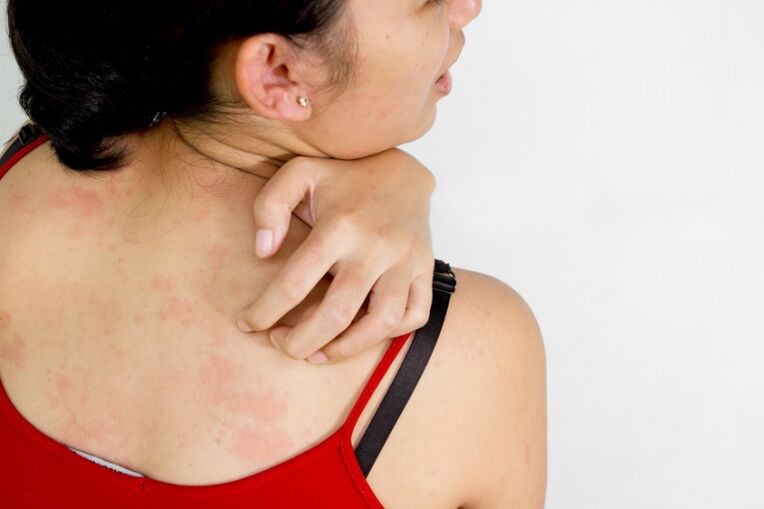
Psoriasis is a systemic disease that affects more than just the skin and nails. It affects the joints, tendons and spine, immune system, nerves and endocrine.
But still, the main manifestation of the disease occurs on the skin. The name squamous lichen quite accurately conveys the symptoms of psoriasis. The first manifestation is usually a bright pink or red papule with a correct round shape, covered with scales - psoriatic plaques. They are located symmetrically, mainly on the surface of the extensors, lower back and scalp. But they can affect any part of the skin and mucosa of the genitals. Its size is from a few millimeters, in the early stages, to ten centimeters or more.
Depending on the characteristics of the rash, such asforms of psoriasis:
- Psoriasis pitting - the size of the element is less than the pin head.
- Guttate psoriasis - papules are torn in shape and reach the size of lentil seeds.
- Coin psoriasis - plaques grow up to 3-5 mm and have rounded edges.
They also distinguish the shape of the rash, when its elements in the form of rings, arcs and garlands, geographical maps with uneven edges.
Papules are covered with a scaly coating that can be easily removed. It is composed of epidermal keratin cells. Psoriatic plaques begin to cover with scales from the center, then the plaques spread to the edges. Its loose and light appearance is due to the fact that keratin cells are absorbed by a space filled with air. Pink rings can form around the element - this is the area of inflammation, the zone of plaque growth. The skin around the rash element does not change.
Scalp psoriasisrepresents a significantly increased psoriatic plaque on the surrounding skin. They are densely covered with dandruff -like scales. In this case, the hair remains unaffected. The rash can occur not only under the hair, but also on smooth skin, on the neck and behind the ears. Such changes are explained by the active division of keratinocytes in the affected area.
Psoriasis of the feet and palmscausing a strong thickening of the stratum corneum of the skin in this area of the body. The skin becomes thick, rough. Cracks often penetrate it. This is due to intensive cell division, which multiply 8 times faster than normal, but are not removed in time from the surface of the skin.
Nail psoriasisdiffer in a variety of symptoms. But most important are the two main types of damage to the nail plate:
- According to the type of "thimble". Small holes form on the nail plate, much like the needle stem mark.
- According to the type of onychomycosis. The lesion resembles nail fungus. Nails thicken, change color, flake off. Psoriatic papules surrounded by red rims are visible through the nail plate. It looks like an oil stain shining through a nail.
The symptoms and signs of psoriasis depend on the stage of the disease, which replaces each other cyclically throughout the year. Therefore, most patients have a "winter" type of disease, when exacerbation occurs during the autumn-winter period. The increase in conditions in the summer is due to the fact that ultraviolet light in the sun has a therapeutic effect. But some patients experience a "summer" type.
There are several stages of the psoriasis journey:
- progressive-the appearance of new elements, active growth of existing plaques, implied pink growth zones around it, intense exfoliation and itching.
- stationary - stops the growth of papules, the absence of new rashes, fine folds of the upper layer of skin around psoriatic plaques.
- regressing - the absence of peeling, loss of plaque and the appearance in their place of pigmentation areas, indicating a thinning of the process.
What does a skin rash look like with psoriasis?
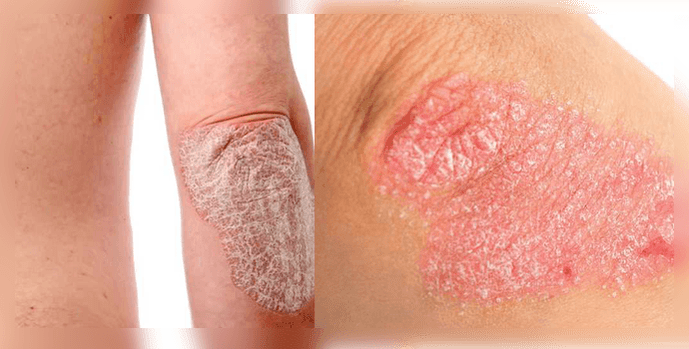
Each organism is individual and responds differently to disease. Therefore, the nature of the rash can be very diverse. This explains the variety of forms and types of psoriasis.
However, for most people, the symptoms of psoriasis are similar. These are red spots - psoriatic plaques, rising 1-3 mm above the level of healthy skin. Their appearance is due to the fact that the cells of the surface layer of the skin - keratinocytes, dividing very actively, do not have time to mature and turn into full epithelial cells. As a result of this increased pathological growth, certain areas of the skin thicken. This is due to the fact that immune cells release chemicals that cause inflammation in the skin.
From above, the plaque can be covered with a gray, silvery or yellowish bloom, which looks like paraffin. Hence, they got the name - "paraffin lake". These are keratin epithelial cells, the rejection of which is affected and it accumulates on the surface of the affected skin area.
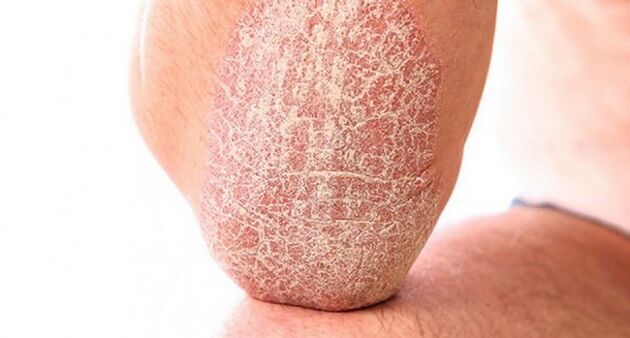
The spots are flaky, hotter than other parts of the skin, and can grow to large sizes. Often patients feel severe itching in this place. This is due to the fact that, against the background of inflammatory processes, cascades of neuro-reflex reactions and allergic reactions occur.
Another type of element is papule. These are small elements of a rash that resemble a tubercle. Its size is about 1 mm. In the middle there is no cavity filled with contents. They are usually located at the knee and elbow joints. They remain even during the period when the disease subsides.
During exacerbations, the elements of the rash gradually grow in width and merge with neighboring plaques. During the period of improvement (remission), the spots begin to brighten from the center. They gradually take the shape of a ring and are completely soluble. After plaque, the effect remains on the body - pigmentation. It can be much lighter or darker than the skin around it. After a person is tanned, the skin color usually becomes even.
What do nail lesions look like in psoriasis?
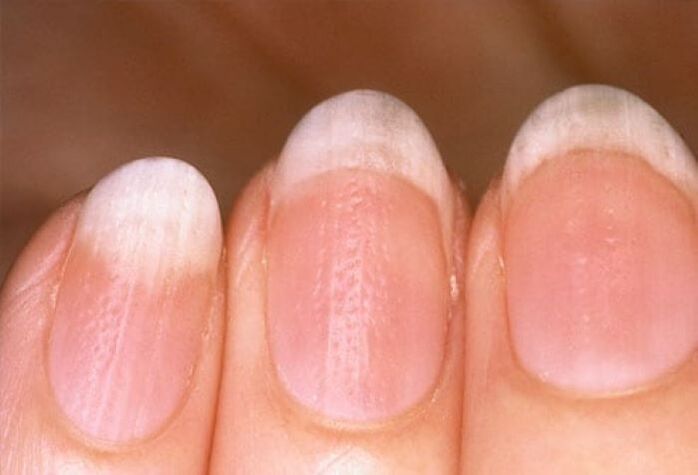
Nail psoriasis is similar to a fungal infection on the nail plate. For a correct diagnosis, it is necessary to conduct laboratory analysis. Changes can affect only one nail or all at once and are very diverse. They occur in 10-15% of patients. Damage to the nails is often accompanied by joint pain caused by psoriasis. In this case, there may be no skin rash.
Nail psoriasis has several stages:
- depressed point - thimble nails
- longitudinally depressed groove
- transverse compression in the center of the nail, these first signs are associated with damage to the root of the nail - the nail matrix
- "Oil spots" pink spots of irregular shape that appear through the nail - this is the accumulation of serous fluid under the nail
- nails become dull, cloudy, yellow and thickened due to circulatory disorders
- the nail plate takes on the appearance of a bird's claw, which is accompanied by pain. This is due to the fact that the process captures the nerve endings.
The nail wound starts from the edge and gradually moves towards the root, covering the entire surface. Microcirculatory disorders cause nails to become blurred and change color from yellow to bluish.
If you find similar symptoms in yourself, do not diagnose yourself. The same changes can be caused by other reasons: fungus, trauma, and impaired blood supply.
Is psoriasis contagious?
This question is often asked by those who have just been diagnosed with the disease and patient contacts. Scientists give a clear answer about it. Psoriasis is not contagious, and people who are sick are completely safe for others. This is because psoriasis is not caused by a virus or bacteria, but by aggressive white blood cells. These immune cells themselves, for unknown reasons, attack the skin cells, causing skin inflammation. The result of this process is a rash and thickening of the skin in some places (psoriatic plaques).
How is psoriasis treated?
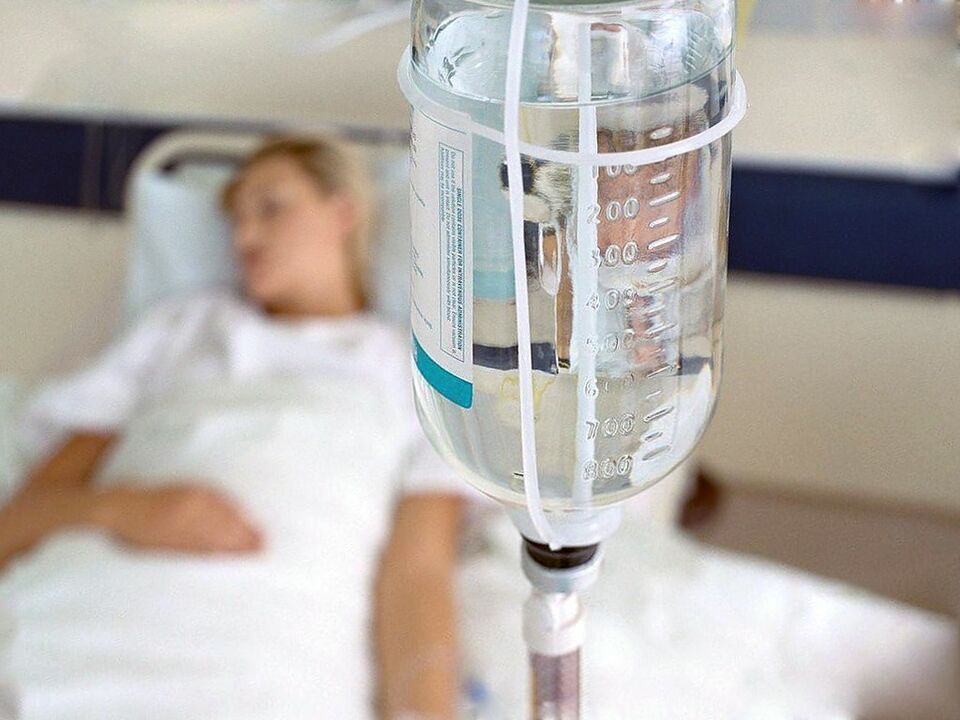
Treatment for psoriasis depends on the form and stage of the disease and on sensitivity to medications. Traditional medicine focuses on drug use. Treatment begins with a local preparation that acts on the affected skin. Therefore, they try to avoid the side effects that occur when taking the drug by mouth. Further details on the use of local remedies will be described below. Now let's think about pills and capsules.
There is a technique when, first, the patient is offered more gentle medication with the least number of side effects. If it is not effective, it is replaced with a more potent one, and so on. Even in the case when the treatment is suitable for the patient, after a while it is changed. The fact is that the body gradually gets used to the drug and its effects diminish.
Oral systemic medications are very effective. They are prescribed for moderate and severe stages of the disease. They help even patients whose treatment in other ways does not yield positive results. However, they have significant drawbacks: they can cause serious side effects, and after the abolition of these funds, the situation worsens.
| Drug group | Dosage form and effect of the drug on the body |
| Retinoids - derivatives of vitamin A | Affects the maturation of the surface layer of the skin and eliminates disturbances in this process caused by psoriasis. Release form - capsules. Dosage according to the scheme, depending on the stage, 30-75 mg / day. Reduces the rate of keratinocyte division, promotes normal maturation and cell differentiation. Available in capsules. The daily dose is 25-50 mg. |
| Immunosuppressants - drugs that reduce the activity of the immune system | Reduces the activity of T-lymphocytes, which causes increased skin cell division. Sterile solution in ampoules. The initial dose when administered intravenously is 3-5 mg / kg per day, for oral administration-10-15 mg / kg per day. |
| Drugs for the treatment of malignant neoplasms (Cytostatics) | Inhibits excessive growth and proliferation of atypical epidermal cells. Available in tablets. Give 2. 5-5. 0 mg orally, 2-3 times a day, 1 time a week. |
Physiotherapy treatment for psoriasis is very effective. They bring significant relief to patients, stop the progression of the disease and, in some cases, serve as a safe substitute for medications.
| Physiotherapy methods | Effects on the body |
| PUVA therapy or photochemotherapy | Combination of long wave ultraviolet irradiation and internal photosensitizer. This course is 20-30 procedures. This method is based on the fact that UV rays penetrate deep into the skin. Photosensitizers inhibit skin cell DNA synthesis and its rate of division. For treatment, special installations or cabins are used. |
| Selective phototherapy (S. F. T) | Skin irradiation with ultraviolet radiation with a wavelength of 280-320 nm. This course is 15-35 procedures. Special booths are required for therapy. |
| Monochromatic UV treatment | Exposure to each focus separately with a laser or UV light source. It makes it possible to radiate focus even in hard -to -reach places, without compromising healthy skin. It is prescribed in cases where less than 10% of the skin is affected. The course of treatment is 15-30 procedures. |
| Laser therapy | For the treatment of rashes, laser radiation with different wavelengths is used. Lasers promote rapid absorption of psoriatic plaques, protecting against the appearance of scars in their place. The doctor determines the number of procedures individually for each patient. |
| Electrosleep | The procedure is performed on a device based on mild effects on the brain with weak electrical impulses. Duration 20-60 minutes. The number of procedures is 10-12. Electrosleep has a calming effect. As a result, the activity of the nervous system becomes normal, plaque begins to dissolve, and the period of well -being begins more quickly. |
| Magnetotherapy | Treatment with magnetic fields has a good effect on the general condition. Itching and inflammation of the skin, swelling and pain in the joints are reduced, the psychoemotional state is improved. Betatron devices are used for treatment. The duration of the procedure is 20 minutes. Number of each course 10-15. |
| Ultrasound therapy | It is used as a painkiller, antipruritic and decongestant. Promotes scar absorption. This procedure can be combined with drug administration (phonophoresis). The duration of exposure to one area is 15 minutes. To get a therapeutic effect, 7-14 sessions are required. |
| Hyperthermia | Heat the fabric to a temperature of 40 degrees using a special pillow with a heat mixture. This effect on the body normalizes the function of the immune system, and it reduces attacks on the skin. The duration of the procedure is about 2 hours. Their number is determined by the doctor. |
| Treatment of bee venom | The material is introduced into the body using electrophoresis or ultrasound equipment. Anti-inflammatory, absorbable, antipruritic effect is achieved. Metabolism becomes normal. The minimum number of procedures is 10. |
It is very important for those with scaly lichen to follow a diet. Eating disorders can make the disease worse. The menu should be rich in vitamins and at the same time simple. It should give rest to the intestines and liver, and also not cause allergies to the body.
| Authorized Products | Prohibited food |
| Vegetables (pumpkin, watermelon, beets, carrots, potatoes, radish) | Animal fat |
| Fruits (apricots, peaches, apples), juices | Alcohol |
| Berries (except red berries: strawberries, raspberries, red currants) | Fatty meats (pork, duck) |
| Fresh herbs | Smoked meat |
| Lean meats (beef, beef, rabbit, turkey) no more than 200 g per day | Red fish |
| Cheese, cottage cheese, dairy products | Carbonated drinks and coffee |
| Peanuts | Eggs |
| Types of low fat fish | Ice cream and milkshakes |
| Seaweed | Minimum amount of cakes and sugar |
| Wheat Bread | Butter and puff pastry |
To cleanse the body of toxins and metabolic products, it is necessary to carry out fasting days twice a week. They recommend kefir, apples, vegetables.
What ointments are effective in treating psoriasis?
The use of ointments for psoriasis brings the greatest effect compared to other external preparations. The components of the ointment do not remain on the surface of the plaque, but soften the scales and get into the skin.
There are a large number of ointments available to treat psoriasis. In the first stage, appointointment is not a hormone.
If the treatment does not give the expected effect, then sethormone ointment. . . Treatment begins with a milder medication that has minimal side effects. If improvement is not achieved, then a stronger ointment with glucocorticosteroids is prescribed.
| The name of the ointment | Drug action | Side effect |
| Weak ointment | Suppresses increased activity of leukocytes, prevents their movement into the skin, eliminates the feeling of tightness and itching. | Swelling of the skin, itching, redness. |
| Simple ointment | It has anti-inflammatory, anti-allergic, anti-edema, antipruritic effects. Suitable for patients with exudative form psoriasis, reduces bleeding. Apply in a thin layer to a limited area 2-3 times a day. Treatment lasts 10-14 days. | Steroid acne, atrophy and stretch marks of the skin, burning, itching, hypopigmentation. |
| Strong ointment | Local anti-inflammatory, antipruritic and anti-allergic agents. Reduces skin moisture. Apply to the affected area 2-3 times a day for up to two weeks. Used during exacerbations. | Skin atrophy. |
| Very strong ointment | It has a strong antipruritic and anti-allergic effect. Slows down the process of cell division and keratinization. Apply 1-2 times a day for no more than two weeks per course. | Acne, hair loss, skin atrophy. Do not use for pustular and widespread plaque psoriasis. |
Pharmaceutical companies produce many drugs in the form of ointments. The doctor individually selects the medication for the patient and, if necessary, changes it to a stronger one.
Do not forget that in case of psoriasis you should not neglect a visit to the doctor. After all, the disease may hide the early stages of skin cancer.
Choosing a treatment regimen for psoriasis is a long process that involves a lot of trial and error. Don’t despair if you don’t find "your" remedy right away. Remember that many people achieve lasting improvement when the disease does not return for years. You can do it too!























